Meeting local Jews was one of the goals of my visit to Iran. Besides curiosity and scholarly interest, practical concerns such as finding kosher food and celebrating the Sabbath and the holiday of Purim also brought me in contact with Iranian Jews. Besides, I was invited to give academic lectures on the way Jewish law (halakha) treats Islam and Muslims.
Compared with many other Jewish communities in today’s world, Iranian Jews seem safe. There are no guards at the entrances to synagogues and Jewish institutions, just as it used to be when I first came to know Jewish venues in Montreal, Baltimore and Paris. My memories, admittedly vague, of the synagogue in Leningrad during my youth do not include any image of guards, let alone armed soldiers who guard synagogues in major European cities. Most of the Jewish homes that I visited are quite modest. This, of course, did not prevent them from being very hospitable.
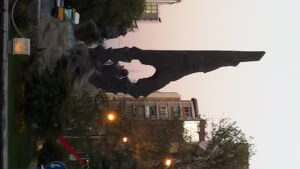
My discovery of Jewish life in Iran began on the Sabbath. On Friday afternoon I walked to the synagogue along the Palestine Avenue. The street leads to the Palestine Square in the middle of which stands a monument to the Palestinians’ struggle. On the way I also saw a picture of a tank accompanied by a quote from Khomeini “Israel must be omitted from the world” (sic). This sentence was written on a large firewall facing the street. This sentence had been mistranslated and manipulated, leading to a panic, real or feigned, in Israel and among its fans elsewhere, who mistook it for a call “to wipe the country off the map” and thereby annihilate its population.
Nearby stands a spacious building of the main synagogue, which also houses a Jewish school, a kolel and a kosher restaurant. The door was wide open, and I saw congregants were getting ready for the afternoon services. There was a portrait of Hofetz Haim prominently displayed at the entrance, and a few phrases from his book against bad mouthing. But a local friend took me across the street to a smaller synagogue, the floor of which was entirely covered with carpets. This is the custom of almost all of the synagogues I saw in Iran. After taking off shoes we were seated in a place of honor, and the prayers began.

In about a dozen of synagogues that I attended during my stay in Iran, the prayers, whether on the Sabbath or weekdays, were never rushed. The morning service of Purim in one of the synagogues in Yazd lasted three hours, including the reading of the Book of Esther. There was a feeling that everything read should have a sense. The showing of the Torah scroll to the congregation, often rather perfunctory in other countries, is taken seriously in Iran; the scroll is exhibited slowly so that everyone can actually find the verse they are about to hear. Every service includes a few minutes of Torah comments made by one of the congregants. Exceptionally, this time, a young man read out the results of the parliamentary elections that had taken place that week. A medical doctor, whom I would meet later, had been elected as the representative of the Jewish community.
The pronunciation of the prayers is quite close to the Sephardi one, but some tunes remind me of the Yemenite ritual. When I was subsequently often invited to conduct the services in several synagogues, the congregants found my style quite congenial, except for a few ayin and het, which Persians do not articulate. The decorations of the synagogues are functional and include the texts of the kaddish, modim, and a few Psalms, most often Esa einai el he-harim (Psalm 121), which is exceptionally popular here, perhaps, because of the proximity of the mountains.
The following day I went to another synagogue, an even smaller one, rather cozy and comfortable. People feel quite at home there, serve tea in the beginning of the services, and wine with a variety of cookies right before the reading of the Torah. Like in most non-Ashkenazi synagogues, congregants lead the services and read the Torah without the help of hired manpower. There was a lot of back-patting and kissing, and, the women are seated in the back, without a partition (with the exception of the main synagogue that does have a partition about 80 cm high). Women participate in all the three daily services, not only on the Sabbath, and most of them pray and seem familiar with the liturgy.
My friend took me home for both meals with his parents and sister. Unlike my friend and his sister who speak fluent English, their parents speak only Persian and we could exchange just a few words, usually borrowed from prayers or the Torah. The atmosphere in Iran is propitious for religious observance. Jewish children who attend public school (a Jewish school exists only in Tehran) are exempt from classes of Islam. They are sent instead to study with a rabbi who is obliged to grade their performance and send the results to the school. This way, all Jewish children receive traditional Jewish education so long as they go to school. I was moved in Shiraz when a boy of seven or eight years old interrupted me as I was about to lead the congregation to a grace at the conclusion of the last Sabbath meal. He said: mayim aharonim hova, reminding me of the custom of rinsing one’s fingers and lips before saying the grace after meals.
In Tehran, there are four kosher restaurants, a Jewish school, a yeshiva and a kolel as well as fifteen synagogues. One of the rabbis is a graduate of Baltimore’s Ner Yisroel yeshiva, where he spent eight years. The community is also in touch with Iranian Jews in Los Angeles and New York, where they get most of the prayer books and bilingual editions of the Pentateuch. Some have lived in the States and in Israel and have come back, sometimes to get married to a fellow Iranian.

People were always helpful and generous with me. After one morning service in the main synagogue in Isfahan, a fellow congregant when I asked where to get a cab, took me to my hotel on a motorcycle. On another occasion, when I went to the synagogue complex to get kosher food and found the restaurant locked (it was Iranian New Year, Nouruz,) a synagogue attendant offered me a meal instantly prepared by his wife.
In Isfahan I often heard that the city had been founded by Jews exiled from the Holy Land in the First Exile. The city used to be called Dar al-Yahud. No wonder that I went to explore the old Jewish quarter Jubaré. As I wandered, I saw a small Star of David hand-painted on a gate. I pushed it and found myself in front of two elderly women. I tried to explain to them that I was Jewish but they remained in doubt. I tried to speak with them in Hebrew, again no avail. Finally, I uttered Torah tsiva lanu Moshe, and they joyfully responded morasha kehilat Yaakov. This is traditionally the first verse of the Torah taught to a child: “Moshe commanded us the Torah, the inheritance of the community of Jacob.” (Deuteronomy 33:4) The contact was made, and they promptly put me on Skype with a relative who spoke Hebrew. Apparently, she was in Israel but insisted she was in America.
Soon a young man with a kipa showed up in the street. I uttered tefilat minha, “afternoon prayer”, and he led me to a synagogue clearly marked in Hebrew and Persian above the front door. The synagogue was small and cozy, at least a century old. It was decorated with quotes from the Psalms, parts of prayer. Men sat in one corner and women in the other. I was invited to lead the services, and was afterward treated to fruit and cookies in memory of a deceased congregant, whose anniversary happened on that day.
When we left the synagogue, a familiar scene took place, even though I did not understand what was being said. It was Thursday night, and several people argued who would invite me for the Sabbath meals. I gave up all attempts to influence the events, and it was only on Friday night that I was actually led to the home of the parents of the young man with the kipa, who inhabit a spacious home not far from Palestine Square where the main synagogue is located.
Besides the young man and his parents, there were two of his sisters as well as a man who spoke English since he had spent a few years in Queens. We all sat on the carpet, making a Kiddush, partaking of fruit and vegetables prior to breaking bread in order to augment the number of blessings. We ate mostly with hands. After a while I was asked to say a few words of Torah, and, inspired by a weekly broadcast from Akadem, I spoke about the two names of the tabernacle, mishkan and mikdash, which teach us about the pitfalls of excessive closeness and possessiveness. The man from Queens interpreted, and the “audience” applauded. They applauded again when I told them that before a public lecture in Tehran, in response the Islamic invocation bismillah, “in the name of God”, I said in Hebrew be-ezrat ha-shem ve-yeshuato, “with the aid of God and his salvation”. The atmosphere was joyful throughout the evening, and I left close to midnight to walk to my hotel. On the way, I crossed the park Hasht behesht, full of couples and groups of teenagers visibly having a good time.
The next morning I walked to Jubaré in search of the synagogue where my host for the second meal was to meet me. I got lost and walked into another synagogue, where nine men were anxiously awaiting the tenth one. Under the circumstances I had to stay. The floor was covered with blankets, rather than carpets, and the synagogue looked poorer. An old man asked me to lead the services, and once again, here I was reciting prayers before members of the oldest community in the world. It was moving to pray in the minuscule synagogue, surrounded by verses and old ornaments.
After the services, the old man who was commanded respect in the synagogue took his bicycle and headed home. Then I saw another Jew on a bicycle, which I had never seen among observant Jews. I would later find that Ben Ish Hai (1832-1909), a major authority in Jewish law from Baghdad, authorized the use of the bicycle under certain conditions.
My host easily found me since everyone knows each other in Jubaré. I was hosted for lunch by a family: the parents and a son in his 30s. Trained as an engineer, he sells clothes at a relative’s store, earning significantly more than he would in his profession. Later I met a mathematician who was selling carpets in the city’s famous bazaar. These are signs of demodernization, partly caused by Western sanctions meant to stop the non-existing nuclear weapons program in Iran.
The burly head of the family, with a few teeth missing in his mouth, spoke some French, since he had once studied at the Alliance school in his neighborhood. He was hospitable, albeit not always punctilious of the Sabbath observance, and his wife had to discipline him from time to time. A one-gallon whiskey bottle full of homemade wine dominated the table full of meats, stews and vegetables. The host told me that the bottle was a vestige of pre-revolutionary times. The lunch was copious, and included, to my surprise, Salade Olivier, which, thanks to Russian influence, became quite popular in Iran. By then I knew that hosts often offer their guests spacious shalvar, cotton pants that one uses to sit at the meal and, if needed, to take a nap afterwards. This turned out to be the case, and after the nap I changed back to my clothes and went out to explore the city. Returning to the neighborhood, I was greeted Shabbat shalom by a Jew who had keys to a few more synagogues, which he kindly showed to me. They are open only on Shabbat.
Friends in Isfahan introduced me to Mr. Sasson, artist, architect and owner of the gallery where we met him. He is also the only Jew to work as an official building assessor in the city. As one enters the gallery, one sees an ornate picture of Jerusalem with the biblical verse in Hebrew “If I forget thee, O Jerusalem, Let my right hand forget her cunning” (Psalm 137:5). He remains committed to Judaic practice and mentioned that he had seen me in the synagogue. His son teaches Iranian music. An amiable refined man, Sasson extended me a warm welcome and patiently answered all of my questions about the Jewish community, gave me advice about travel in the country as well as a few contacts. He has taken part in over 40 exhibits, traveled around the world, while his gallery is situated on the ground floor of the house that used to belong to his parents, a few hundred meters from the main synagogue. Like several intellectuals I have met, he resigned from his position of professor of architecture during the years of Ahmadinejad, when universities reportedly experienced a sharp decline. At the same time, he believes Khomeini did a lot of good to the Jews, repeatedly referring to them as equal and “pure” Iranians.
Several non-Jewish Iranians, including business people, mentioned to me that Jews have an excellent reputation for honesty and reliability. Their word is as good as a written contract. This image appears at variance with the European image of the Jew, often considered “cheap”, “dishonest” and “rapacious”. One Jewish businessman, a carpet dealer, came to see me in the hotel and spoke with me in Hebrew without lowering his voice or feeling otherwise uncomfortable. He effusively greeted me shalom as he was leaving and was not in the least embarrassed to do so. In fact, Iranian salam often sounds very much like Israeli shalom.
I met Sion Mahgerefte, the head of the Jewish community of Isfahan, in the lobby of Hotel Kowsar, one of the most prestigious in the city. The New Year decorations were splendid, and we found a quiet corner nearby. A friend interpreted as he spoke only Persian. He told me that most Jews work in the clothing industry, usually in retail. There are a few professionals and intellectuals but most earn a living in business, often inherited from father to son. Sion has a company of safety equipment (helmets etc) but his children study to be professionals.
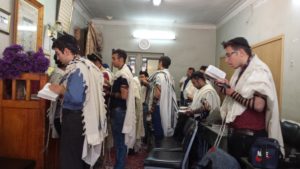
Shiraz welcomed me early in the morning and I settled in hotel Niayesh (meaning “prayer”), which turned out to be located not only near the city’s main shrine but also across the street from a small building marked Bet ha-knesset ha-hadasha (sic), “The new synagogue”. Soon I met a local Jew, a well-spoken graduate student at the University of Shiraz, according to him, one of the best schools in the country. When I asked him if there was a synagogue service to say gomel, a blessing usually uttered in public after travel, he remarked that Shirazis are proverbially lazy, and that there would be a late – fifth – minyan (prayer quorum) in the main synagogue. Indeed, we were on time for the 9:30 service, with about 30 young people, mostly in jeans, making the congregation. I later sent a photo of the service to a few friends who did not know where I was, and none guessed it was Iran, saying that the picture could be taken anywhere in the world.
The building also houses a kolel. After the services, I saw a group of boys studying the initial sentence of Mishna Berakhot under the tutelage of a young teacher. Someone explained to me that these were Jewish pupils from public schools who are obliged to study Judaism in synagogues. The rabbi teacher regularly examines them and sends the results back to school. Thus, concluded my Jewish interlocutor, the Islamic republic creates a religious framework that makes it easier to be a Jew. Several local Jews told me about their disappointment with the non-observance of so many Jews in Israel. One said that if he were to move there he would choose Bnei-Brak, the Haredi bastion next to Tel Aviv. Iranian Jews do not cover their heads, many are quite worldly and modern, while at the same time punctiliously observant. This contrasts with the use of the code word “modern” to denote less and non-observant Jews among the Ashkenazim. Here the modernity does not clash with Judaic observance.
On the way back, my friend showed me rows of clothing stores, many of which Jewish-owned. When I took that street on the Sabbath, quite a few stores remained closed in spite of the brisk business the rest of them were doing on the eve of the New Year.
I also found a Jewish campus consisting of an old age home, a matzah bakery, a wedding and festivities hall, a few offices and two take-out snack bars, a dairy and a meat one. The entrance to the courtyard was wide open, and over the entrance one could see a slogan with a photo of Khomeini and his words about the inclusive character of Iranian society. As usual, there was no guard, and anyone could drive a truck through. I later went there to savor delicious kebab served with rice and grilled vegetables.
At breakfast in my hotel on Friday I met a Lithuanian, who had become so impressed with Persian mysticism, that she moved to Shiraz and started a business bringing groups of her compatriots to visit Iran. She showed me around and by the end of the day, as we reached the hotel, I told her, in Russian, that I would check out, pay (I was leaving on Saturday evening) and then go the synagogue. Suddenly a middle-aged lady to my left questioned me in French: “Vous avez dit synagogue? Is there a synagogue in the city?” and asked me to take her and her son there. On the way, she began to deplore the fate of Iranian Jews – whom she had never met by then – who must live under an “anti-Semitic government.” On the way I tried to explain to her that opposition to Zionism need not be anti-Semitic, but did not make much headway. She considers herself a proud secular Jew and an unconditional supporter of Israel. Her son is doing a master in contemporary history in Berlin, is multilingual and otherwise worldly.

In the synagogue, the young man was lost since he could barely follow the prayers. After the prayers, they could not understand why total strangers would invite them for supper to their home. I did what I could to provide them some information about Jewish customs but I left before that story ended. The contrast between local Jews and these fiers juifs laics, proud secular Jews, could not be starker.
My last “Jewish” stop was Yazd, a town known for its sweets and beautiful mosques (as well as the birthplace of the disgraced Israeli president Moshe Katsav). Since I was in the south, I decided to forego the opportunity of reading the Book of Esther at her supposed tomb in Hamadan and to spend Purim with Jews in the small community of Yazd. My friends were driving there anyway, and I caught a ride with them. As the sun began to set, the traffic became impossible, and I concluded it would be faster to walk to the synagogue. The son of an Iranian friend was asked to accompany me, and we spent nearly half an hour struggling through holiday crowds swarming in the commercial streets. He must have asked for directions over a dozen of times, and most merchants knew there was a synagogue nearby and told us how to reach it. In fact, there turned out to be two synagogues, one disaffected (but with a Hebrew inscription over the door) and the other that I was by then desperately seeking. I reached it just as the congregation was about to begin the reading. I found a place and a book and followed with the rest of about fifty people gathered. The reading was solemn and measured, and nobody was rushing out to eat after a day of fasting that precedes Purim.
At the end of the services, the head of the community approached me and invited to break the fast in his home. On the way, we could barely understand each other but at his place, full of relatives and their spouses and children, a few people spoke some English and French. The house was was warm and hospitable. As the local custom wants, I was offered a shalvar. Two sons of the head of the community were proud to work as accountants for one of the wealthiest men in town. The wife of one of them works as a tour operator. The atmosphere was joyful and relaxed, people were coming and going, sitting down to eat and drink, and then leaving again.

I inquired if a non-Jewish Iranian friend, who studies Persian influences on the Talmud, could attend the morning services; he gracefully agreed, suggesting, though, that she should not say she was not Jewish. As it turned out, she responded she was Kurdish, and this was just fine for a few curious ladies among whom she sat.
The following morning the entire community of about 50 people was again gathered at about 7 a.m. to hear the megila, the Book of Esther. As I mentioned earlier, the service lasted about three hours, and I was given the honor of carrying the Torah scroll from the arc.
After the services, a community meal was put together with a variety of Iranian dishes (again including Salade Olivier) brought in by families. Homemade wine was also flowing freely since Purim is the only holiday on which Jewish tradition encourages abundant libations and even drunkenness. Of course, nobody got drunk at 10 am in the middle of an Iranian city.
Back in Tehran, I was invited to give a lecture about Jewish opposition to Zionism since several members of the community knew my book on this subject that had been translated and published in Farsi. It took place Tuesday evening, and the audience in the little synagogue where I had prayed on a previous Shabbat, consisted of about fifty members of the community, mostly professionals. This time nobody removed the shoes: apparently this is done only during prayers. Before the talk, I was introduced to Dr. Siamach, the Jewish member of Parliament who had just bought my book in Persian and was passing it around. Collective pictures were taken from a good dozen of cameras, and the atmosphere was warm and friendly by the time I began to speak.

There was a lively interest to the history of Zionism, to rabbinical objections to it, particularly since most referred to Ashkenazi rabbis and to a world of ideological division and conflict that Iranian Jews have never experienced. (They knew, however, serious personality clashes between rabbinical authorities. One such conflict about kosher food a century ago resulted in physical violence. A shelter was built in the old Jewish neighborhood of Tehran to provide haven for Jews threatened by other Jews. Finally, it was an ayatollah, who restored peace among Jews.) There were four or five people, including the MP, who asked most questions, and it was truly moving to discuss this topic in Tehran with Iranian Jews, who need not to be convinced that Zionism is not equal to Judaism. If there is a country where Jews really appreciate my book it is Iran. I felt that it is for this Jewish community, the oldest in the world, where it is vitally important to distinguish between Judaism and Zionism, that I had really written my book. This made me feel privileged to have been able to meet them.
The following day, Marjan and her father, former head of the Jewish community and film producer, showed me several old synagogues, the Jewish hospital and other Jewish landmarks. One was the oldest in the city in continuous use. He showed me a few, including one decorated with Psalms, another with ancient rimonim (silver ornaments) and other synagogue utensils, protected by police alarm. One of the synagogues is called “Polish” in memory of the Jewish refugees, children and adults, who landed in Tehran during the Second World War. Another synagogue, Bet ha-knesset he-hadash, or the new synagogue, was built in 1879 as an imaginary Jerusalem temple.
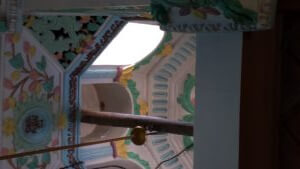
Marjan mentioned that her father Yeshayai used to be close to Communists and other political dissidents prior to the Islamic revolution. It was during that time that he befriended a Muslim revolutionary who ended up emigrating. He returned years later, and his name was Ayatollah Khomeini. The two would keep up their relationship, and Yeshayai continued to head the community. He had to resign under Ahmadinejad because he had accused, in a journal article, the new president of fascist tendencies. The article was published, the author was not arrested but had to leave the post of the head of the community. However, at 84, he continues to be involved, and had the keys to all the synagogues he was showing me.
Marjan also told me about her work, which includes a report on the health impact of the Western sanctions on Iran. She has since sent it to me, and it makes for very sad reading. Marjan also “warned” me that she is not religious, but I found her quite competent in matters Jewish. In the courtyard of one of the synagogues there was a lonely bush growing, apparently planted to make havdala around it. It has a pleasant smell and she suggested I made a blessing atsei vesamim, a blessing over fragrant substances usually pronounced at the end of the Sabbath but meritorious whenever one feels a sweet scent.

We also saw the Jewish hospital. It is clearly marked as such with a Torah verse in the original: “And you shall love your neighbor like yourself”. Unlike Montreal, where the Jewish hospital was a response to the anti-Semitism of the medical milieu that would not hire Jewish doctors in the 1920 and 30s, the Jewish hospital of Tehran is a Jewish charity work. It began as an infirmary at a synagogue, later a few houses were donated, and finally an entire hospital was built. Located in a former Jewish neighborhood (most Jews have moved to better areas), the hospital treats all patients equally. The neighborhood, and its Jews, had played an important role during the Constitutional Revolution of 1906-1911.
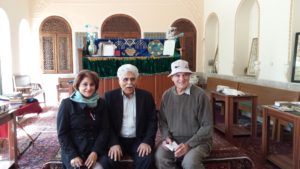
The last stop in the guided tour was a pleasant caravanserai that used to house the first Jewish bank and currency exchange counter. It is now a (non-kosher) restaurant but the building carries a commemorative plaque.
After the walk through the neighborhood we ended up in a kosher restaurant for lunch. Nothing is written about it being kosher but people know, and, according to Marjan, most customers were Jewish, albeit only a handful of men had their heads covered. While practically all observe kosher regulations, they may not necessarily adhere to the custom of saying the grace after the meal.
I was told that practically all Iranian Jews are observant. Judaic practice is the foundation of their Jewish identity; this is what one does if one is Jewish. There are no substitutes for Torah commandments as a linchpin of the Jewish identity, no Zionism, no secular Jewish literature, no Israeli dances and, of course, no school courses on Israel advocacy. In this sense, Jewish community finds itself as a part of a millennial continuity while many of its members are nowadays electronic engineers, medical doctors and other professionals. They do not follow an ideology, be it Rabbi Hirsch’s Torah im-derekh erets (Torah and worldly pursuits) or Rabbi Soloveitchik’s teachings; they simply continue to “live Jewish” while remaining Iranians and engaging in modern professional pursuits.
In a conversation with Tehran Jews I mentioned Jeffrey Goldberg who did not visit the country but published an offensive comment comparing Iran’s Jews with a petting zoo. My Jewish interlocutors in Tehran were aware of the article but simply shrugged it off.
The warmth and authenticity of Iranian Jews I was lucky to meet deeply impressed me. In Iran I found committed Jews who go about modern life in a seemingly natural manner, without the self-consciousness and identity-splitting of their Ashkenazi brethren. The fact that this happens in a conservative Muslim country points at drastic differences between the history of Jews in the countries of Islam and that of European Jewry. One should not idealize the life of Jews in Iran who have had their share of challenges. But their life stands in contrast to a well-oiled campaign to besmirch the history of Jewish-Muslim relations in order to suit a political agenda, the agenda of those who argue that there is no safe place for Jews except Israel.
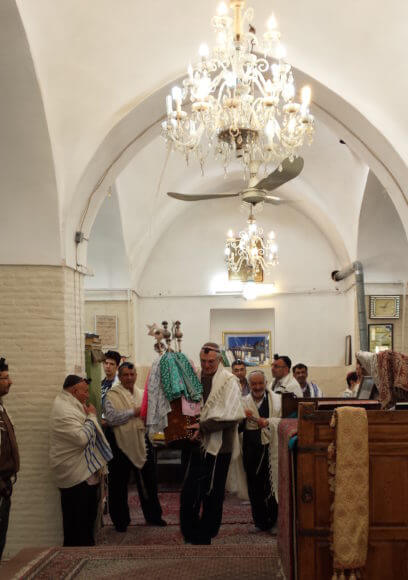
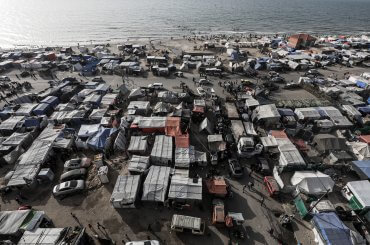
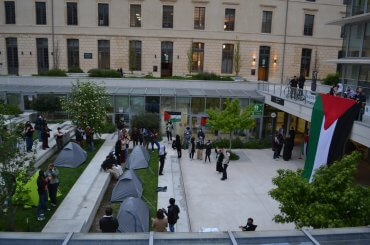
Thank you for a very interesting account. I would like to see the position of Jews in Iran placed in the context of the position of all religious minorities. The minority that has suffered the worst persecution is the Bahai and I wonder what their situation is now.
I saw a video about Zoroastrians in Iran. Small communities survive in mountainous areas and have recently been permitted to resume open religious practice. Iran is one of only two countries where Zoroastrian communities survive (the Parsees in India being the other).
I don’t know whether there is a Christian community in Iran. Also I wonder about the position of Sunni Moslems. Are they treated better than Shia in Sunni-dominated countries like Saudi Arabia and Bahrain?
Many thanks for this honest and tremendously important article, Professor Rabkin.
I am grateful for your efforts to delve into and illustrate with your experience what I have witnessed myself. My own impressions and reflections of my experiences have mostly been met with fierce and insane (yes, insane) opposition from ardent Zionists and the wilfully, stubbornly blind and the uninformed/ignorant xenophobes/Iranianphobes/Afghanphobes/Arabphobes/Islamophobes.
Try to explain that Jewish folk have not been terrorized by everyone on the planet, and the vitriol hits the roof.
The fact is, Iranians are pretty cool and embarrassingly hospitable in comparison to their Western brothers and sisters. So are Palestinians, Afghans, Iraqis, and others in MENA.
“The warmth and authenticity of Iranian Jews I was lucky to meet deeply impressed me. In Iran I found committed Jews who go about modern life in a seemingly natural manner, without the self-consciousness and identity-splitting of their Ashkenazi brethren. The fact that this happens in a conservative Muslim country points at drastic differences between the history of Jews in the countries of Islam and that of European Jewry.”
;-)
You’ve offered the world a great opportunity to gain/learn some of the most important truths through your telling of your experience.
I thank you.
Interesting article. Questions…
Did the author have minders at any point during his travels?
Persians don’t have any modern history of antipathy for jews other then what was typical for a Muslim society in terms of social, legal and employment issues embodied in the custom of dhimmitude .
Wether those here believe it or not the 20-25,000 Jews left in Iran enjoy lives free of constant fear but with a large% of Iranian Jews living in Israel there have been times the remaining Jewish population is held as a dangling bargaining chip should any escalation arise.
4 kosher restaurants in a major city?
With a tyrannical mullah regime it’s hard, maybe not impossible, but hard to believe statements about Jewish life I Iran as told by Jews are all that reliable unless there is complete anonymity as Iran is not know for permissive for those critical to foreign press.
While It cant be determined how many of the Iranian Jews are truly anti-zionist, just prefer living in Iran or can’t be open is a question. It’s certain that many Jews prefer to remain in Iran while there are often family members living in Israel.
Bottom line: while many nefarious plans are being cooked up by Khameini and his IRG for the region and it’s expansionist goals it’s doubtful that any harm to Iranian Jews are part of those plans except as a possible contingency in the event hostilities ensure between Iran and Israel.(at
Otherwise, this piece comes off as no different then an Israeli article on e.g. : how the leaders of some neighboring Palestinian tribes came to share the Succah in a Jewish town in Judea. Or how far a poor Arab girl rose through Israeli system to become a superior court judge. Touchy feely
An extremely fascinating article for me. Full of interesting nuggets apart from the overall picture of Jewish Iranian life.
Beautiful architecture too.
It was great to have such insight into life in Iran. I found the article very interesting, and it clearly gave us a glimpse of life for these Iranian Jews. They seem to be very peaceful people, who have assimilated very well with their fellow Iranians, and able to follow their religion in peace. Shame on Israel, the US and others, who demonize Iran, and conveniently fail to mention the positive side to it. The US and Israel has one goal, and that is to eventually bomb the only Arab nation standing. Israel is tare jealous neighbor whose main intention is to make sure centuries of Iranian culture and history is wiped out. The world has constantly heard the threats against Iran, from Nutty holding up cartoon bombs, to Bush calling them one of the “axis of evil”, and it is ironic these countries keep whining that it is Iran that is dangerous.
Who appointed Avigdor Lieberman Saudi Arabia’s champion.? It is strange that Israel has
suddenly become Israel BFF. Dangeorus liaisons.
http://www.reuters.com/article/us-mideast-crisis-israel-iran-idUSKBN15Y0AD